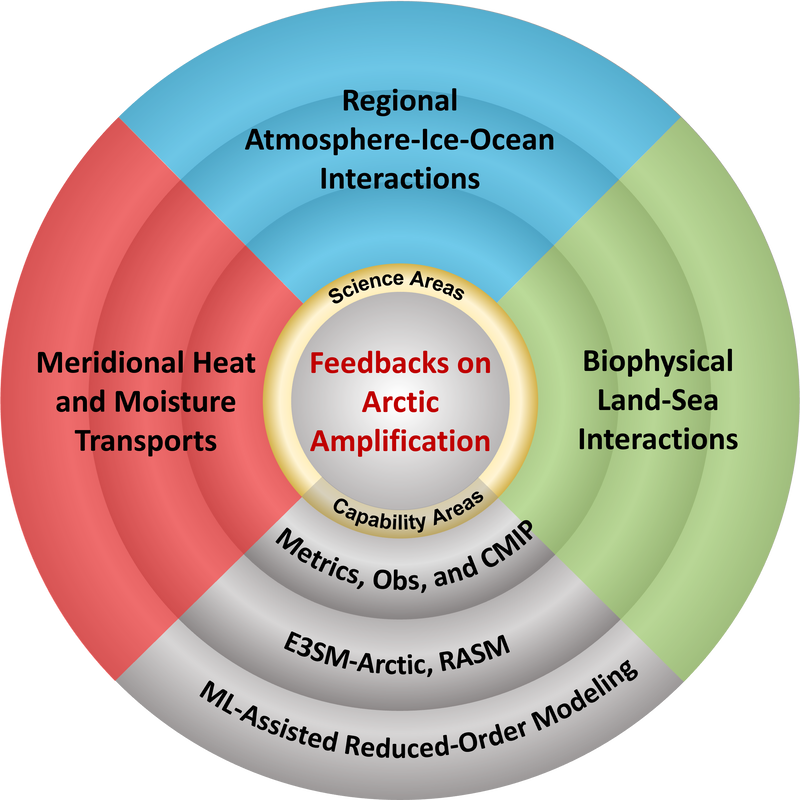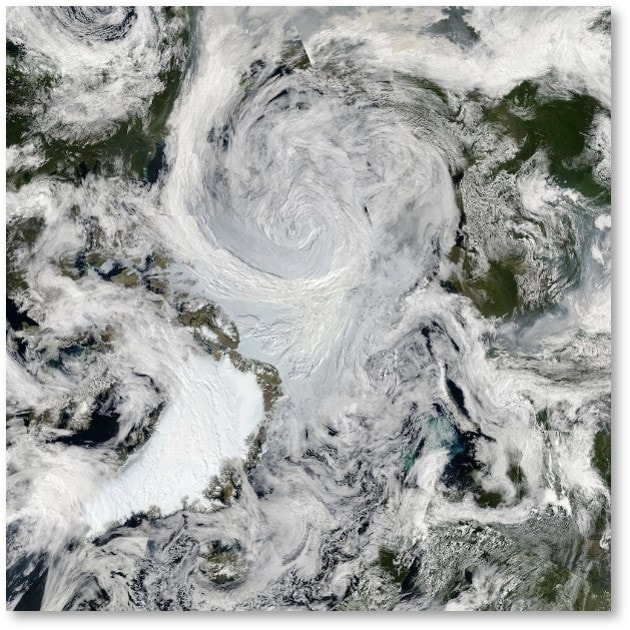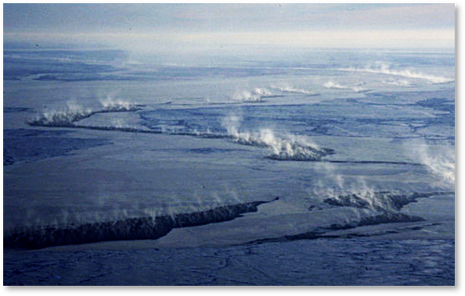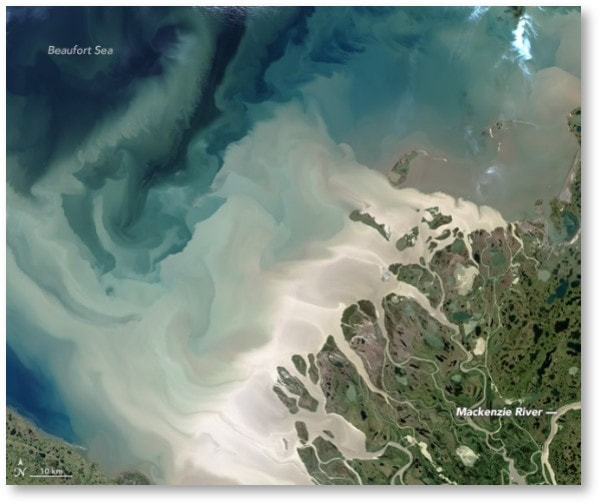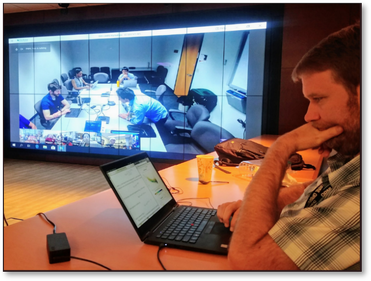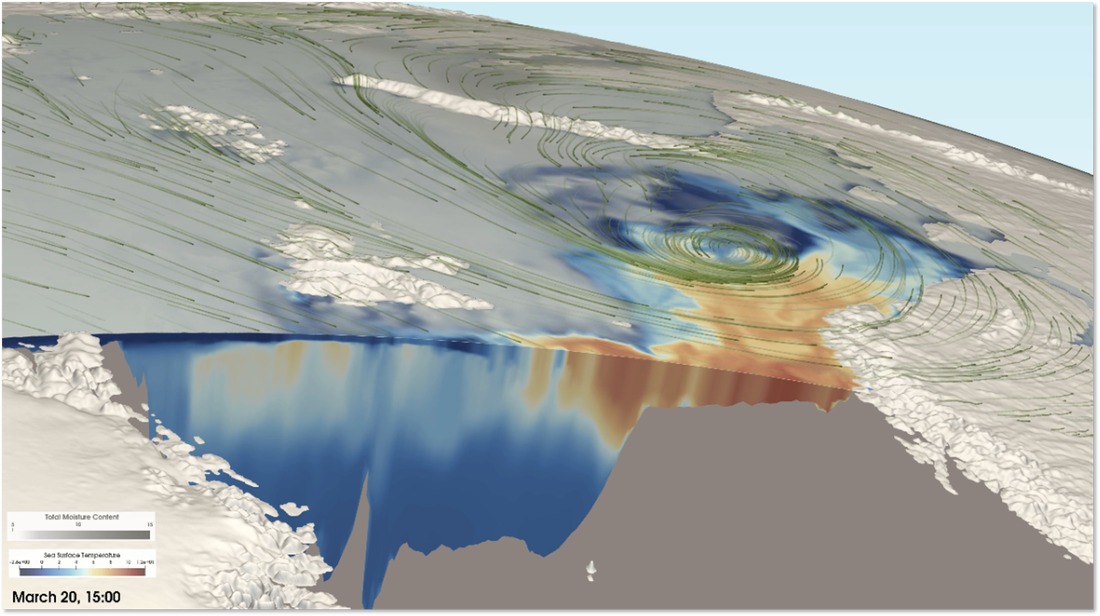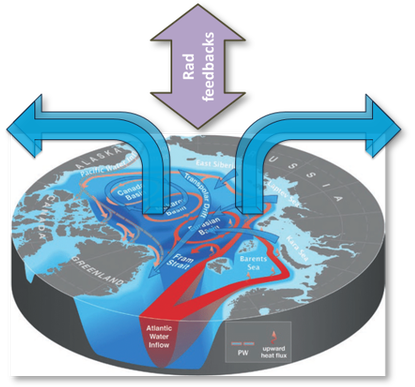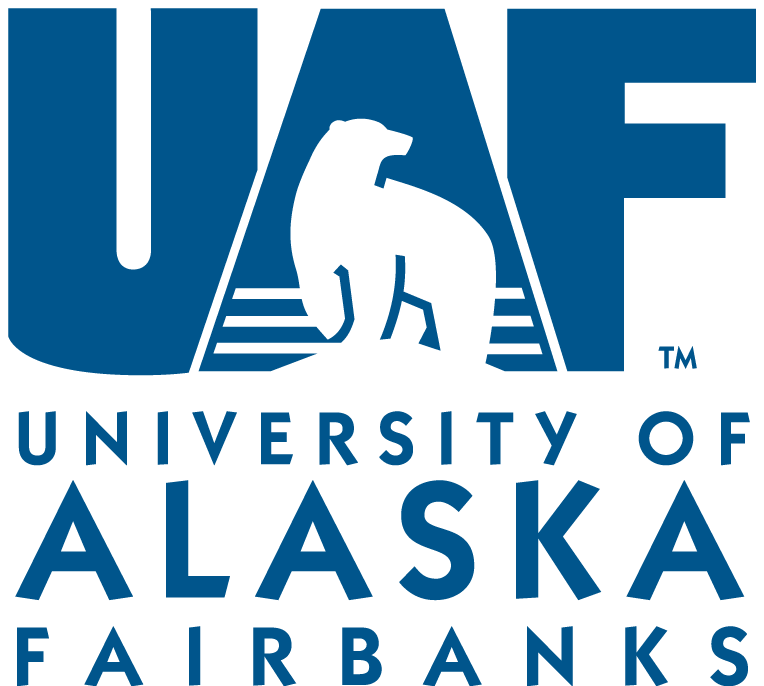Our Research
|
The High-Latitude Application and Testing of Earth System Models (HiLAT) Science Focus Area is teaming up with the Regional Arctic System Model (RASM) project to study exchanges and feedbacks that contribute to Arctic Amplification (AA). This accelerated warming is having major and unprecedented impacts on numerous aspects of the Earth system within and outside the Arctic. Our ability to project these changes is hampered by incomplete knowledge of the complex feedbacks that contribute to AA and by the challenges of translating this knowledge into model fidelity.
HiLAT-RASM Phase III aims to improve our ability to accurately project future Arctic changes by developing a unifying framework to understand, quantify, and compare complex Earth system feedbacks that modulate AA and to improve their representation in Earth system models. The framework is designed to unify feedbacks across two dimensions: first, we will investigate feedbacks from a wide range of processes represented by three Science Areas (SAs), namely meridional exchanges of heat and moisture between high and low latitudes (SA1); complex regional feedbacks between the ocean, sea ice, and atmosphere (SA2); and complex physical and biogeochemical interactions and feedbacks between the terrestrial, aquatic, and marine domains (SA3). Second, we will study feedbacks across models with a range of complexities represented by three Capability Areas (CAs), namely from broad-ranging multi-model examination in the CMIP6 ensemble (CA1) through detailed investigation in our highly resolved models E3SM-Arctic and RASM (CA2) to interpretable, data-driven, machine learning-assisted reduced-order models (CA3). |
Science Area 1: Meridional Heat and Moisture Transports
SA1 concerns feedbacks between Arctic warming and heat and freshwater/moisture delivery by ocean and atmosphere meridional transports. Poleward heat transport by the ocean (OHT) and atmosphere (AHT) influences high-latitude energy budgets on sub-seasonal to decadal scales and beyond. Although climatological heat transport toward Polar Regions is dominated by the atmosphere, the ocean and atmosphere appear to play similar roles in low-frequency variability and long-term trends. CMIP5 and CMIP6 models disagree on the relative quantitative contributions of poleward OHT and AHT, adding significantly to the inter-model spread in AA and associated feedbacks. In Phase III, we will investigate how Arctic feedbacks amplify or attenuate heat content anomalies imparted by OHT variability, how the atmosphere responds to and feeds back on this Arctic warming through changes in AHT, and how changes in atmospheric circulation patterns affect OHT into the Arctic.
|
Science Area 2: Regional Atmosphere-Ice-Ocean Interactions
AA depends critically on a collection of interacting processes and feedback among the strongly coupled Arctic climate system components, including atmosphere, ocean, ice, and snow. Some of the most discussed climate feedbacks are the ice/snow surface albedo, lapse rate, water vapor, and cloud feedbacks, which have received substantial investigation in the Arctic. Yet, their relative contributions to AA are still not fully understood. Compared to observations, most CMIP6 models still fail to reproduce historical Arctic warming, sea ice loss, and/or the magnitude of AA. Moreover, there are numerous radiative and thermodynamic Arctic feedbacks and their nonlinear interactions that have not received nearly as much attention. SA2 will build upon the past studies to provide a more comprehensive assessment of feedbacks and their relative or changing importance in a warming climate driven by internal variability and external forcing, aiming to quantify coupled feedbacks operating across the atmosphere-ice-ocean interfaces for their seasonal contributions to the energy budget, AA and global changes.
|
Science Area 3: Biophysical Land-Sea Interactions
Riverine processes connect the continents to the ocean and have a large impact on coastal ecosystems and sea ice. Riverine and coastal processes have recently been gaining increased attention in ESMs, but their feedbacks with the larger climate system are not well quantified and require further study. SA3 involves interactions between polar warming, terrestrial hydrology, and radiative properties of the coastal Arctic Ocean. This includes processes related to the land-ocean fluxes of heat, nutrients, water, and sediments, as well as changes in radiative properties of the ocean and ice as a function of river fluxes, marine ecosystem productivity, and biogeochemical transport. These processes involve complex cross-component interactions that may not be well-represented in ESMs, in some cases because we lack fundamental understanding of the underlying mechanisms and in other cases because we lack quantification of their relative importance at a large scale. Investigation of these processes and interactions using a combination of observations and models will allow us to quantify their relative importance in the context of ESMs and to determine whether they need to be included or better represented in large-scale models.
|
Capability Area 1: Metrics, Observations, and CMIP
CA1 will contribute to the unifying framework by building and expanding resources of observations and community model output (e.g., CMIP6) for evaluating and implementing metrics that are relevant for identifying and quantifying contributions from different processes to AA. CA1 will also organize model intercomparison studies, focusing on the representation of high-latitude processes and feedbacks in existing ESMs.
|
Capability Area 2: E3SM-Arctic, RASM
CA2 is dedicated to applying physically-based numerical modeling tools that are configured with special attention to simulating relevant processes of the Arctic climate system. These tools are the global E3SM-Arctic configuration of the E3SM model with regional refinement of the horizontal resolution in the Arctic and subarctic, and RASM with its regional pan-Arctic configuration.
|
Capability Area 3: Machine Learning-Assisted Reduced-Order ModelingCA3 provides general cross cutting capabilities to assess the complex, multi-component feedbacks of HLES. This capability involves constructing a Reduced Order Model (ROM) of the Earth system based off the Koopman operator. It is built on spatiotemporally varying dynamical modes. The methodology is data-driven, meaning that it can be applied to any dataset (observations, reanalysis, or model simulations).
|

